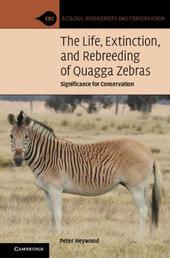
|
The Life, Extinction, and Rebreeding of Quagga Zebras: Significance for Conservation
Hardback
Main Details
| Title |
The Life, Extinction, and Rebreeding of Quagga Zebras: Significance for Conservation
|
| Authors and Contributors |
By (author) Peter Heywood
|
| Series | Ecology, Biodiversity and Conservation |
|---|
| Physical Properties |
| Format:Hardback | | Pages:242 | | Dimensions(mm): Height 235,Width 157 |
|
| Category/Genre | African history |
|---|
| ISBN/Barcode |
9781108831604
|
| Classifications | Dewey:599.6657168 |
|---|
| Audience | |
|---|
| Illustrations |
Worked examples or Exercises
|
|
Publishing Details |
| Publisher |
Cambridge University Press
|
| Imprint |
Cambridge University Press
|
| Publication Date |
19 May 2022 |
| Publication Country |
United Kingdom
|
Description
Quaggas were beautiful pony-sized zebras in southern Africa that had fewer stripes on their bodies and legs, and a browner body coloration than other zebras. Indigenous people hunted quaggas, portrayed them in rock art, and told stories about them. Settlers used quaggas to pull wagons and to protect livestock against predators. Taken to Europe, they were admired, exhibited, harnessed to carriages, illustrated by famous artists and written about by scientists. Excessive hunting led to quaggas' extinction in the 1880s but DNA from museum specimens showed rebreeding was feasible and now zebras resembling quaggas live in their former habitats. This rebreeding is compared with other de-extinction and rewilding ventures and its appropriateness discussed against the backdrop of conservation challenges-including those facing other zebras. In an Anthropocene of species extinction, climate change and habitat loss which organisms and habitats should be saved, and should attempts be made to restore extinct species?
Author Biography
Peter Heywood is a Professor of Biology in the Department of Molecular Biology, Cell Biology and Biochemistry at Brown University, USA, where he has taught since 1974. He is a Fellow of the Linnean Society and Fellow of the Royal Society of Biology. Most of his scholarship has focussed on the cell biology of algae, protists, animals and plants, but he has also published on development of the inner ear in mammals, agricultural biotechnology, pedagogy and biography. His interest in quaggas started in 2006, and he has written on the history of quagga zebras, their representations in biology, art and literature, and their rebreeding.
|